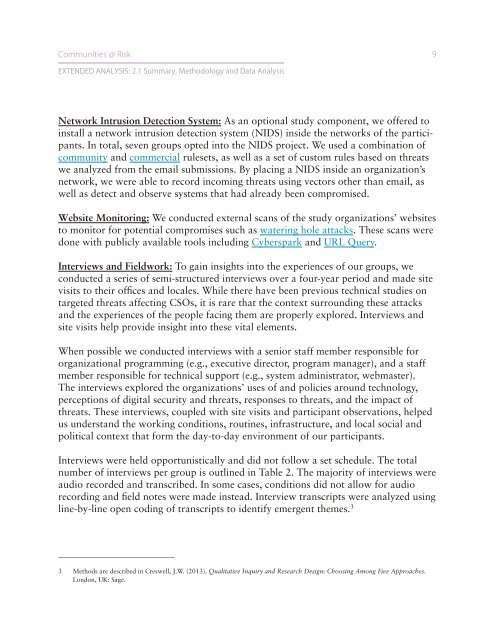2-Extended Analysis-Full
2-Extended Analysis-Full
2-Extended Analysis-Full
You also want an ePaper? Increase the reach of your titles
YUMPU automatically turns print PDFs into web optimized ePapers that Google loves.
Communities @ Risk 9EXTENDED ANALYSIS: 2.1 Summary, Methodology and Data <strong>Analysis</strong>Network Intrusion Detection System: As an optional study component, we offered toinstall a network intrusion detection system (NIDS) inside the networks of the participants.In total, seven groups opted into the NIDS project. We used a combination ofcommunity and commercial rulesets, as well as a set of custom rules based on threatswe analyzed from the email submissions. By placing a NIDS inside an organization’snetwork, we were able to record incoming threats using vectors other than email, aswell as detect and observe systems that had already been compromised.Website Monitoring: We conducted external scans of the study organizations’ websitesto monitor for potential compromises such as watering hole attacks. These scans weredone with publicly available tools including Cyberspark and URL Query.Interviews and Fieldwork: To gain insights into the experiences of our groups, weconducted a series of semi-structured interviews over a four-year period and made sitevisits to their offices and locales. While there have been previous technical studies ontargeted threats affecting CSOs, it is rare that the context surrounding these attacksand the experiences of the people facing them are properly explored. Interviews andsite visits help provide insight into these vital elements.When possible we conducted interviews with a senior staff member responsible fororganizational programming (e.g., executive director, program manager), and a staffmember responsible for technical support (e.g., system administrator, webmaster).The interviews explored the organizations’ uses of and policies around technology,perceptions of digital security and threats, responses to threats, and the impact ofthreats. These interviews, coupled with site visits and participant observations, helpedus understand the working conditions, routines, infrastructure, and local social andpolitical context that form the day-to-day environment of our participants.Interviews were held opportunistically and did not follow a set schedule. The totalnumber of interviews per group is outlined in Table 2. The majority of interviews wereaudio recorded and transcribed. In some cases, conditions did not allow for audiorecording and field notes were made instead. Interview transcripts were analyzed usingline-by-line open coding of transcripts to identify emergent themes. 33 Methods are described in Creswell, J.W. (2013). Qualitative Inquiry and Research Design: Choosing Among Five Approaches.London, UK: Sage.


